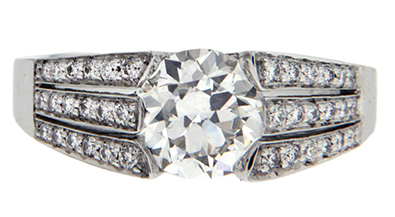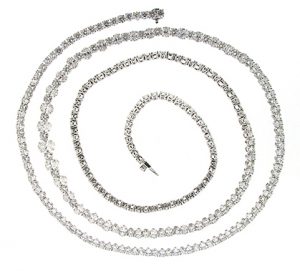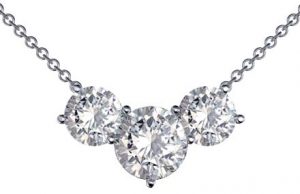Diamond Lasers
Diamonds are both beautiful and practical. The highest quality stones are usually set aside to be cut and set in jewelry. Less perfect gems and those made in laboratories are frequently used for industrial purposes. Diamonds’ hardness makes them ideal as abrasives, drill tips and cutting instruments. Other applications include heat sinks and lasers.
The optical properties of diamonds have been admired for centuries. Its ability to reflect light has inspired many jewelers to improve upon previous diamond cuts, creating as much brilliance and fire as possible. Diamonds can also fluoresce, or glow under ultraviolet light. Some jewels can even change color under daylight or incandescent.
Due to diamond’s hardness, heat tolerance and way with light, they are being tested as components in lasers. Experiments with lab produced diamonds and lasers that utilize a process called stimulated Raman scattering show the stones work with a wider range of wavelengths and produce more powerful beams than other materials. Additional research is determining if more potent results will occur with diamonds of greater size and crystal quality.
Rough Diamond Shapes
 When people think of diamond shape, they often think of faceted jewels and their outlines. Just as finished diamonds come in ovals, squares, circles and others, rough diamonds also have variety in their forms. These shapes can influence how the diamond will be cut, and in turn, the jewel’s market value.
When people think of diamond shape, they often think of faceted jewels and their outlines. Just as finished diamonds come in ovals, squares, circles and others, rough diamonds also have variety in their forms. These shapes can influence how the diamond will be cut, and in turn, the jewel’s market value.
Most rough diamonds follow a similar pattern. The essence of diamonds is made of five carbon atoms, one in the center surrounded by the other four. Diamond’s smallest possible unit is four of these atom clusters bonded together. Enough of these cells together will establish a repeating crystalline pattern. From these building blocks, diamonds frequently take on geometric shapes which echo the original unit cells.
Diamonds belong to the cubic crystal system due to its molecular structure. Naturally occurring cube shaped gem quality diamonds are very rare. Cubes with perfectly flat sides are rarer still. However, cubic planes exist within all diamonds, parallel to the square center of an octahedron. These planes allow for easier sawing when it comes to processing diamonds for cutting.
The most famous of rough diamond shapes is the octahedron, resembling two pyramids connected to the same square base. This form of rough may have rounded or sharply defined edges and corners. Diamond octahedrons may also feature triangular indents on its sides. This type of diamond rough is well suited for sawing in two, and turning each portion into a princess or round brilliant cut.
Dodecahedral crystals are made of twelve sides. Few have perfectly flat planes, but more likely have a rounded appearance. Depending on the deposit, twelve-sided gem quality diamonds may be plentiful. Quirks in pressure and temperature in these locations may have influenced the dodecahedral shape. In terms of cutting, the shape is popular for cutting into round brilliants.
During diamond formation, a stone may end up forming separate orientations, a process known as twinning. In some jewels, this may manifest as two crystals growing from the same base. With diamonds, the most common expression is a flattened triangle known as a macle. Rather than forming the edges needed for an eight or twelve-sided piece, the change in direction keeps the gemstone short and wide. Macles are often transformed into trilliants, hearts and other fancy cuts.
Some diamonds lack an apparent form. This may be due to octahedrons and dodecahedrons combining to make diamond crystals of many sides, which may be harder to identify than simpler shapes. Others may have been worn down from external forces, such as flowing water. Two of the largest diamonds mined, the Cullinan and the Excelsior, had irregular rough shapes. The latter was specifically described as resembling “half a loaf of bread.” Such stones may be split and transformed into round brilliant or fancy cuts.
About Carbonado
Diamonds whose orientation changes partway through creation are known as twinned crystals. Stones whose orientation changes every which way but are connected through intergrowth or naturally occurring binding are known as aggregates. Carbonado is a diamond aggregate with graphite and amorphous carbon mixed in.
As with other diamonds, carbonado has a Mohs hardness of 10, meaning only other diamonds can scratch it. Due to how its individual crystals bond together, it’s also the toughest form of diamond, with increased resistance to damage from blows. The rock is opaque, usually black or dark grey. These properties make carbonado best suited for industrial purposes such as abrasives.
The largest rough diamond ever found is known as Carbonado do Sergio. It was found in 1895 in Bahia, Brazil. Carbonado do Sergio measures 3,167 carats, or 633.4 grams. By comparison, the gem quality rough of the Cullinan diamond weighed 3,106.75 carats.
Tight Knit Diamonds
Diamonds are the hardest known natural substance, and can only be scratched by other diamonds. Another substance, graphite, has the same chemical formula as diamonds but is soft enough to use as pencil lead. The difference between their respective durability is due to the way their carbon links together.
Graphite has carbon atoms linked together in a honeycomb pattern. The mineral is made of sheets of this lattice stacked on top of one another like pages in a book. This weak connection between the layers allows graphite to come apart with little force.
The crystal structure of diamonds is made of a single carbon atom connected to four other atoms. Their bond is accomplished through sharing electrons, which keeps the pieces close together. Multiple five-atom segments link to one another through mutual electrons, creating the gemstone. With the unit cells and individual atoms so closely bonded, the diamond becomes very difficult to scratch or break.
While diamond atoms have a tight bond, some connections are closer than others, depending on direction. In a typical eight-sided diamond, the planes parallel to the square center are loose enough to allow for sawing. Along the surfaces of the eight sides, the jewel is hard enough to make polishing difficult, while similar planes inside the diamonds are far enough apart to split from a strong blow. Planes along the edges of the diamond are the hardest parts of the stone, but slightly to the side of them are the softest parts of the diamond, making sawing and cleaving easier.
Carats and Karats

When looking for jewelry, a person may often hear the word “carrot.” The homophones “carat” and “karat” are used to refer to jewelry quality, though in different aspects. A 14-karat ring has a different meaning than a half carat diamond ring. Knowing the difference between the two words can help eliminate confusion when looking for diamond pieces.
“Carat” is one of the four Cs of diamond quality, referring to the size of a diamond. It measures the weight of a stone, with one carat equaling a fifth of a gram. Diamonds become rarer as their size increases, making one carat stones more valuable than two half carat jewels. Stones are weighed on carefully designed scales and measured to the fifth decimal place before it’s rounded up to the second decimal.
“Karat” measures the purity of gold, with 24 karats being as close to 100% as possible. Since gold is a soft metal, it’s frequently alloyed with other metals to add durability, preventing dents and other damage when worn. Gold jewelry in the United States is often sold as 14 or 18 karat, though higher and lower grades are also available.
Diamonds, Grease and Light
For a diamond to be its best, it must interact with light in an optimal fashion. When a diamond is cut, each facet acts as a mirror to help illuminate its interior and return brilliance to the eye of the viewer. Polish helps to further optimize a diamond’s shine. Diamonds also have an attraction to grease and oils, which can complicate its brightness.
When diamonds and oils meet, they like to stick together. Attraction to oily things is an asset when used correctly. In mines, grease covered conveyer belts help workers distinguish rough diamonds from ore. Overburden is more likely to wash off, while diamonds have a greater chance of staying in place.
Oils are not as helpful with diamonds that are already cut, polished and mounted in jewelry. Diamonds are cut to reflect light as it travels from the air directly to the gemstone. Grease spots alter the angles light needs to brighten a diamond while the facets remain unchanged. Light then leaks through the sides of the jewel instead of reflecting out from the table and into the eyes of the viewer.
While oil and diamonds cling together, the connection isn’t permanent. One of the simplest ways to keep diamond jewelry looking pristine is to wipe it before and after putting it on. Another means of keeping diamonds free of grease is to wash them with warm water, a few drops of mild detergent and a soft toothbrush. Once clean, brilliance is restored.
Diamond Luster
The interior of a diamond, is not the only place the jewel reflects light. “Luster” refers to light reflecting off the surface of the stone. Not only does this trait enhance internal brilliance, it hints at the jewel’s construction. This in turn is used to help distinguish diamonds from other jewels. Before advances in cutting, the inside of diamonds appeared dark. As the stone’s brilliance was little understood, greater emphasis was placed on its luster. When polished, diamonds have a surface sheen seen in few other transparent or translucent jewels. This brightness hints at the refractive qualities of the jewel.
Luster is one of the tools used to identify gemstones. Different minerals have different sheens, depending on how they’re put together. A clear but vitreous looking stone is unlikely to be a diamond, while a gem with a fibrous interior may look silky. Depending on the jewel, luster can even exhibit gem phenomena, like a star in a ruby. There are many classifications of luster, including vitreous, pearly, resinous and metallic. Diamond is adamantine, or “diamond-like.” The jewel’s closely packed atoms provide a smooth surface for light to play across, while stones with coarser texture have more diffuse luster. Diamond’s intense hardness also allows the jewel to take a strong polish, adding to its supreme shine.
Diamonds and Refraction
When light hits the table of a faceted diamond at certain angles, it changes speed and direction. This behavior is known as refraction. While it occurs in other objects, diamond’s refractive qualities are notable for several reasons, making the jewel distinct from other stones. Though light is extremely fast, it slows down and bends as it passes through an object. The refractive index measures how much light slows and changes direction when traveling through an item. There’s a tendency for denser items to have greater influence in redirecting light. Diamonds, with their tightly packed atoms, have one of the highest refractive indexes of natural materials. When making brilliant cuts, diamond cutters aim for facets angled to get an optimal amount of light traveling throughout the gem. Just as important is making sure light exits through the top of the jewel to the eye of the viewer. Without this, the diamond appears dark and its refractive qualities are downplayed.
Diamonds and the Rainbow
When viewing a diamond, one might notice flashes of color here and there. Diamonds are most noted for their brilliance, or how they reflect white light. However, white and colored light go hand in hand with contributing to a diamond’s beauty. Due to the stone’s optical properties, one can’t have white light without having color as well.
White light is made of seven different wavelengths which show as the colors of the rainbow. Each of the seven has an individual refractive index, or moves at a different speed through the diamond. By subtracting the RI of violet, with the shortest waves, from red, with the longest waves, we get a jewel’s dispersion. Diamonds have an especially high dispersion, which manifests as fire.
Fire are the hints of color in cut diamonds. When white light hits facets within a specific range of angles, it separates into different hues. While some recombine into white light when they exit the top of the diamond, others remain apart, showing as fire. Careful faceting encourages these rainbows to bounce off of the internal facets of the stone, creating a more dramatic color show.
Those who enjoy fiery diamonds may want to focus on brilliant and mixed cuts. While step cut diamonds are pleasing to look at, they’re cut for qualities other than fire. Asking your jeweler for recommendations on which diamonds in stock are more colorful may help you with your search. The most straightforward way of finding a diamond with the fire you wish is to gently rock it back and forth under mixed or incandescent lighting.
Cut and Proportion
 Brilliant diamonds have been popular for centuries due to their way with light. The most popular version, the round brilliant cut, has been subject to decades of tweaking as jewelers strive to find new ways of optimizing light return. Factors such as symmetry and the number of facets get careful attention, as does proportion.
Brilliant diamonds have been popular for centuries due to their way with light. The most popular version, the round brilliant cut, has been subject to decades of tweaking as jewelers strive to find new ways of optimizing light return. Factors such as symmetry and the number of facets get careful attention, as does proportion.
The 1919 publication “Diamond Design” provided the guidelines by which round brilliants are cut today. It advised a pavilion depth of 43.1%, a 40.75 pavilion angle, a crown height of 16.2%, and a 34.5 crown angle. While modern round brilliants don’t always follow these exact measurements, “Diamond Design” provided a base for others to work with. Variations on brilliant cuts may add facets or use slightly different angles or percentages, but proportion is always kept in mind. For a diamond to be bright, it shouldn’t be too deep or shallow. Its facets and other components, such as the crown, girdle and pavilion should have lengths, widths and depths which complement one another. Proportion in diamonds is about how individual angles and measurements interact and balance. This leads to a diamond able to reflect light throughout its interior, brightening the jewel.
Facets act like mirrors; to illuminate the stone, they must be angled just so, allowing light to keep traveling within the jewel. If a diamond is overly shallow or deep, light escapes from its sides. Instead of showcasing brilliance, dark patches appear. To achieve the best angles, the facets must be proportional.
Diamonds in Motion
As lovely as diamonds appear in photographs or on a shelf, they garner even more attention when worn. The beauty of diamonds isn’t static, but is attractive under many circumstances. A diamond in motion, such as a ring on a person’s hand, is able to experience many types of light from a number of directions, allowing the stone to look its best. Light brings out the best in a diamond, showing off the jewel’s optical qualities. The illuminated interior of a diamond displays many forms of light. While brilliance is the most well-known form of diamond brightness, there’s also luster, or surface shine, fire and scintillation. Fire is the term for the flecks of colored light that appears in diamonds. If white light enters a diamond at specific angles, it splits into the individual colors of the rainbow. Careful faceting encourages the spread and travel of these hues throughout the stone before it travels to the viewer’s eye. Gently rocking the stone back and forth can have a kaleidoscope effect, sending colors dancing around the crystal. Scintillation is the play of light and shadow in a diamond. Small dark spots interspersed throughout the jewel serves to underscore the brightness of the white patches. When a diamond is in motion, like when worn on a pendant, scintillation moves with the jewel and light and shadow constantly trade place. The effect makes the jewel glitter.





